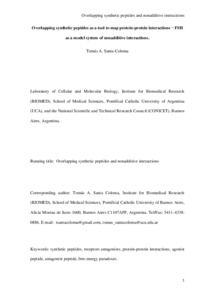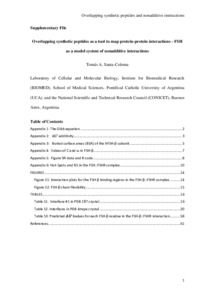Por favor, use este identificador para citar o enlazar este ítem:
https://repositorio.uca.edu.ar/handle/123456789/13975| Campo DC | Valor | Lengua/Idioma |
|---|---|---|
| dc.contributor.author | Santa Coloma, Tomás Antonio | es |
| dc.date.accessioned | 2022-05-17T12:34:59Z | - |
| dc.date.available | 2022-05-17T12:34:59Z | - |
| dc.date.issued | 2022 | - |
| dc.identifier.citation | Santa Coloma, T. A. Overlapping synthetic peptides as a tool to map protein-protein interactions ̶FSH as a model system of nonadditive interactions [en línea]. Biochimica et Biophysica Acta (BBA). 2022, 1886 (7). doi: 10.1016/j.bbagen.2022.130153. Disponible en: https://repositorio.uca.edu.ar/handle/123456789/13975 | es |
| dc.identifier.issn | 0304-4165 | - |
| dc.identifier.uri | https://repositorio.uca.edu.ar/handle/123456789/13975 | - |
| dc.description.abstract | Abstract: In earlier work, we used partially overlapped synthetic peptides as a tool to find regions of interaction between the human FSH hormone and its receptor, aiming to find possible antagonists or agonists. Years later, the FSH and FSH receptor 3D structures were reported by other laboratories. The 3D results were in close agreement with the interacting regions predicted by using synthetic peptides. These earlier studies are reviewed here, and the predicted regions of interaction compared to the FSH and FSH receptor 3D structures to illustrate the usefulness of the synthetic peptide strategy to find binding regions. Different contact regions contribute multiplicatively to the high affinity of the entire ligand; thus, peptides covering a fraction of the anchor sites and with low free energy density cannot reach the affinity of the entire molecule. The earlier use of multiple linear regression to find the relevant predictors for effective binding, and a new way to estimate ΔG° and nonadditive interactions for the synthetic peptides in solution, by using the buried surface area (BSA), will be discussed. | es |
| dc.format | application/pdf | es |
| dc.language.iso | eng | es |
| dc.publisher | Elsevier | es |
| dc.rights | Acceso abierto | * |
| dc.rights.uri | http://creativecommons.org/licenses/by-nc-sa/4.0/ | * |
| dc.source | Biochimica et Biophysica Acta (BBA) Vol.1886, No. 7, 2022 | es |
| dc.subject | PEPTIDO AGONISTA | es |
| dc.subject | PEPTIDO ANTAGONISTA | es |
| dc.subject | PARADOJAS DE ENERGIA LIBRE | es |
| dc.subject | INTERACCIONES PROTEÍNA-PROTEÍNA | es |
| dc.subject | ANTAGONISTAS DE LOS RECEPTORES | es |
| dc.subject | PEPTIDOS SINTETICOS | es |
| dc.subject | HORMONAS GLICOPROTEICAS DE SUBUNIDAD ALFA | es |
| dc.title | Overlapping synthetic peptides as a tool to map protein-protein interactions ̶FSH as a model system of nonadditive interactions | es |
| dc.type | Artículo | es |
| dc.identifier.doi | 10.1016/j.bbagen.2022.130153 | - |
| uca.disciplina | MEDICINA | es |
| uca.issnrd | 1 | es |
| uca.affiliation | Fil: Santa Coloma, Tomás Antonio. Pontificia Universidad Católica Argentina. Facultad de Ciencias Médicas. Instituto de Investigaciones Biomédicas; Argentina | es |
| uca.version | publishedVersion | es |
| item.languageiso639-1 | en | - |
| item.fulltext | With Fulltext | - |
| item.grantfulltext | open | - |
| crisitem.author.dept | Instituto de Investigaciones Biomédicas - BIOMED | - |
| crisitem.author.dept | Laboratorio de Biología Celular y Molecular | - |
| crisitem.author.dept | Laboratorio de Nanotecnología | - |
| crisitem.author.dept | Consejo Nacional de Investigaciones Científicas y Técnicas | - |
| crisitem.author.dept | Facultad de Ciencias Médicas | - |
| crisitem.author.orcid | 0000-0002-3266-1095 | - |
| crisitem.author.parentorg | Facultad de Ciencias Médicas | - |
| crisitem.author.parentorg | Instituto de Investigaciones Biomédicas - BIOMED | - |
| crisitem.author.parentorg | Instituto de Investigaciones Biomédicas - BIOMED | - |
| crisitem.author.parentorg | Pontificia Universidad Católica Argentina | - |
| Aparece en las colecciones: | Artículos | |
Ficheros en este ítem:
| Fichero | Descripción | Tamaño | Formato | |
|---|---|---|---|---|
| overlapping-synthetic-peptides.pdf | 3,71 MB | Adobe PDF |  Visualizar/Abrir | |
| supplementary-file-overlapping.pdf | 15,98 MB | Adobe PDF |  Visualizar/Abrir |
Visualizaciones de página(s)
59
comprobado en 27-abr-2024
Descarga(s)
72
comprobado en 27-abr-2024
Google ScholarTM
Ver en Google Scholar
Altmetric
Altmetric
Este ítem está sujeto a una Licencia Creative Commons

